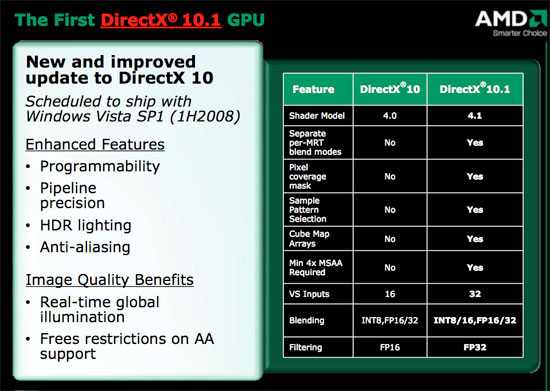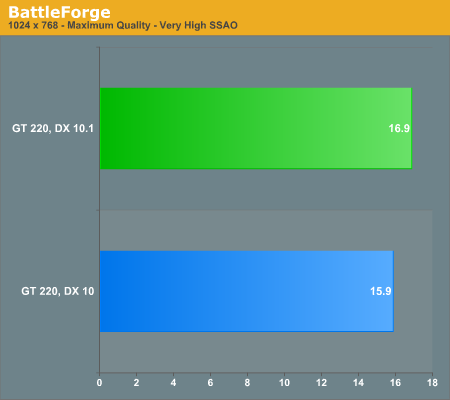NVIDIA’s GeForce GT 220: 40nm and DX10.1 for the Low-End
by Ryan Smith on October 12, 2009 6:00 AM EST- Posted in
- GPUs
DirectX 10.1 on an NVIDIA GPU?
Easily the most interesting thing about the GT 220 and G 210 is that they mark the introduction of DirectX 10.1 functionality on an NVIDIA GPU. It’s no secret that NVIDIA does not take a particular interest in DX10.1, and in fact even with this they still don’t. But for these new low-end parts, NVIDIA had some special problems: OEMs.
OEMs like spec sheets. They want parts that conform to certain features so that they can in turn use those features to sell the product to consumers. OEMs don’t want to sell a product with “only” DX10.0 support if their rivals are using DX10.1 parts. Which in turn means that at some point NVIDIA would need to add DX10.1 functionality, or risk losing out on lucrative OEM contracts.
This is compounded by the fact that while Fermi has bypassed DX10.1 entirely for the high-end, Fermi’s low-end offspring are still some time away. Meanwhile AMD will be shipping their low-end DX11 parts in the first half of next year.
So why do GT 220 and G 210 have DX10.1 functionality? To satisfy the OEMs, and that’s about it. NVIDIA’s focus is still on DX10 and DX11. DX10.1 functionality was easy to add to the GT200-derrived architecture (bear in mind that GT200 already had some DX10.1 functionality), and so it was done for the OEMs. We would also add that NVIDIA has also mentioned the desire to not be dinged by reviewers and forum-goers for lacking this feature, but we’re having a hard time buying the idea that NVIDIA cares about either of those nearly as much as they care about what the OEMs think when it comes to this class of parts.

DX10.1 in a nutshell, as seen in our Radeon 3870 Review
At any rate, while we don’t normally benchmark with DX10.1 functionality enabled, we did so today to make sure DX10.1 was working as it should be. Below are our Battleforge results, using DX10 and DX10.1 with Very High SSAO enabled.

The ultimate proof that DX10.1 is a checkbox feature here is performance. Certainly DX10.1 is a faster way to implement certain effects, but running them in the first place still comes at a significant performance penalty. Hardware of this class is simply too slow to make meaningful use of the DX10.1 content that’s out there at this point.










80 Comments
View All Comments
uibo - Saturday, October 17, 2009 - link
"This could have been a killer HTPC card...one year ago. "... for me to poop on.
VooDooAddict - Monday, October 12, 2009 - link
I'd love to see this around $40 and make it's way into inexpensive OEM desktops. The GT 220 would be perfect for low end desktops if the price gets low enough. This would enable cheap eMachines to play MMOs and keep PC gaming alive.But as it stands right now 4650 and 4670 are the two cards I currently use to build low end desktops for others.
Lonyo - Monday, October 12, 2009 - link
A joke launch for what I can only hope is supposed to be a joke product.Mind you, at least NV have launched _something_ at 40nm for the general market rather than OEMs only.
yoyojam - Monday, October 12, 2009 - link
Glad to see AMD pretty much destroying Nvidia on the graphics front (for now). They're processor division is doing so badly, and we need our CPU competition...MegaSteve - Tuesday, October 20, 2009 - link
I doubt that AMD is destroying or will even destroy Nvidia in any respect. What they are doing is providing them with credible competition and that is what we all benefit from. Although I will say this whole renaming cards and providing meagre performance increases is wearing a little thin.I enjoy the fact that I can choose between similar performance levels in cards from either camp for less money than when the 8800 series came out (I am referring to the GTX/Ultra parts). Now I know I can see your skin turning a solid shade of AMD Red but remember we have no answer from Nvidia yet, so the only thing that has occurred here is that ATI has beaten them to the market - perhaps Nvidia would rather be late and avoid another 5800 Vacuum Cleaner launch, I am sure that cost them dearly.
AMD/Nvidia really have to ensure that they spend time ensuring their products are going to rival the Larrabee/DX 11 threat that very well has the possibility to clean them both up. I would rather have to install a graphics card and a processor of my choice than to have a single intel provider of all in my PC. As you can see nvidia is trying to push multiple uses for their GPU which seems pretty smart to me.
Souleet - Monday, October 12, 2009 - link
They are not destroying NVIDIA. I think we have to wait and see NVIDIA big guns(GT300 series) before we can truly judge who is beating up on who. I consider this a defensive move until Windows 7 release and to see how the market react over the ATI 5800 series. Remember what happen to the ATI 9700/9800 series, we all know what happen after that. :)teldar - Monday, October 12, 2009 - link
ToolSo because nVidia is going to bring out something in 2-4 months, AMD isn't doing better?
And how is an overpriced budget card a response to brand new, high end cards?
They already know how the market has responded to the 5800 cards. As many as they can make are being sold.
Souleet - Monday, October 12, 2009 - link
They only responded because that's like the newest ATI technology since long ass time. When you are down the only way is up or bankrupt. SLI was a knockout blow to ATI and just now they barely catching up.RubberJohnny - Monday, October 12, 2009 - link
Ahh Souleet, you are a candidate for the most uninformed reader on Anandtech.SLI a knockout blow HAHAHA, thats the funniest thing i've read today!
Souleet - Tuesday, October 13, 2009 - link
Really? Then prove to me that SLI wasn't a knockout blow? After SLI came out, who brought ATI? I love ATI but those are the facts. Show me some proof that AMD stock is up since the merger.